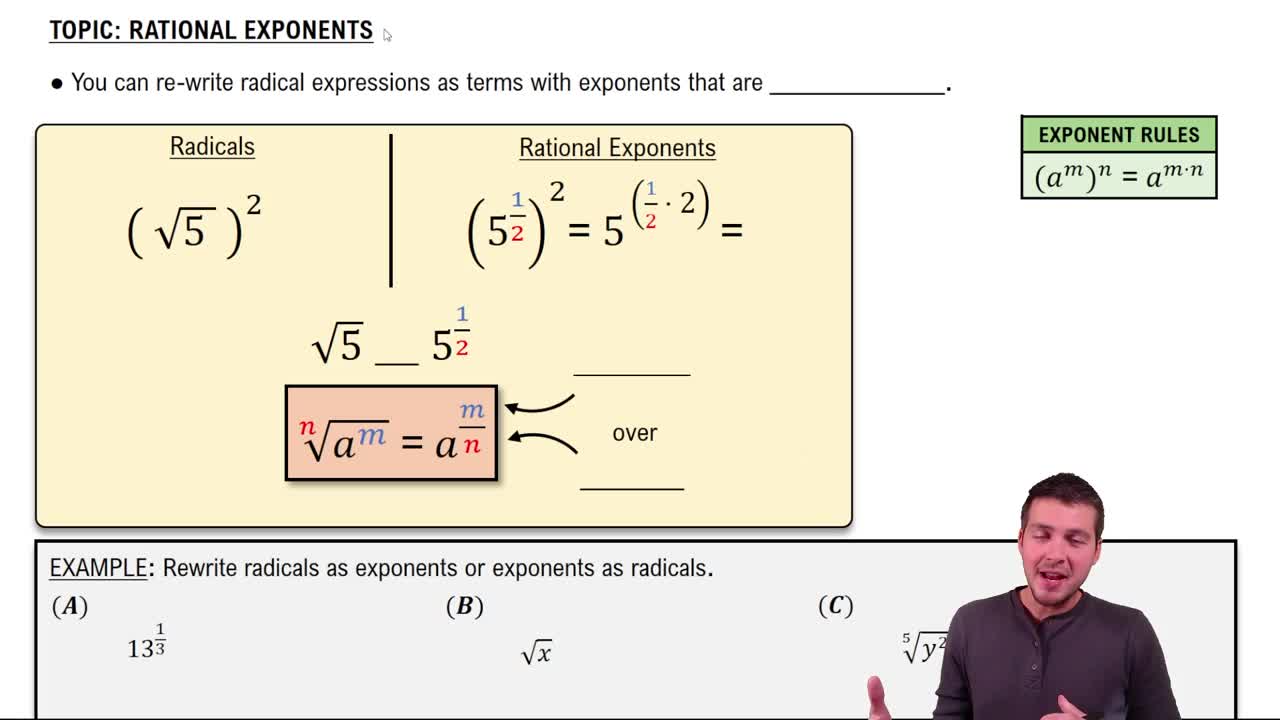Table of contents
- 0. Review of Algebra4h 16m
- 1. Equations & Inequalities3h 18m
- 2. Graphs of Equations43m
- 3. Functions2h 17m
- 4. Polynomial Functions1h 44m
- 5. Rational Functions1h 23m
- 6. Exponential & Logarithmic Functions2h 28m
- 7. Systems of Equations & Matrices4h 6m
- 8. Conic Sections2h 23m
- 9. Sequences, Series, & Induction1h 19m
- 10. Combinatorics & Probability1h 45m
0. Review of Algebra
Exponents
Problem 65b
Textbook Question
Evaluate each expression 125^(-1/3)
 Verified step by step guidance
Verified step by step guidance1
Recognize that the expression \( 125^{-1/3} \) involves a negative exponent and a fractional exponent.
Recall that a negative exponent indicates the reciprocal of the base raised to the positive of that exponent. So, \( 125^{-1/3} = \frac{1}{125^{1/3}} \).
Understand that the fractional exponent \( 1/3 \) represents the cube root. Therefore, \( 125^{1/3} \) is the cube root of 125.
Identify that 125 is a perfect cube, specifically \( 5^3 = 125 \).
Conclude that \( 125^{1/3} = 5 \), so \( 125^{-1/3} = \frac{1}{5} \).
Recommended similar problem, with video answer:
 Verified Solution
Verified SolutionThis video solution was recommended by our tutors as helpful for the problem above
Video duration:
1mPlay a video:
Was this helpful?
Key Concepts
Here are the essential concepts you must grasp in order to answer the question correctly.
Exponents and Radicals
Exponents represent repeated multiplication of a base number. A negative exponent indicates the reciprocal of the base raised to the absolute value of the exponent. For example, a base of 125 with an exponent of -1/3 means we take the reciprocal of 125 raised to the power of 1/3, which involves both negative and fractional exponent rules.
Recommended video:
Guided course

Rational Exponents
Cube Roots
The cube root of a number is a value that, when multiplied by itself three times, gives the original number. In this case, 125 is a perfect cube, as 5 x 5 x 5 equals 125. Therefore, the cube root of 125 is 5, which is essential for evaluating the expression 125^(-1/3).
Recommended video:

Imaginary Roots with the Square Root Property
Reciprocal
The reciprocal of a number is 1 divided by that number. When evaluating expressions with negative exponents, finding the reciprocal is crucial. For instance, the expression 125^(-1/3) translates to 1 divided by the cube root of 125, which simplifies the evaluation process and leads to the final result.
Recommended video:
Guided course

Parallel & Perpendicular Lines

 7:39m
7:39mWatch next
Master Introduction to Exponent Rules with a bite sized video explanation from Patrick Ford
Start learningRelated Videos
Related Practice













